Nursing Research Report: Skin Glue and Peripheral IV Catheters Study
VerifiedAdded on 2020/07/23
|8
|2653
|26
Report
AI Summary
This report presents a nursing research study investigating the effectiveness of skin glue (Cyanoacrylate) in reducing the failure rate of peripheral intravenous catheters in emergency departments. The study employed an experimental design with a randomized controlled trial involving 360 adult patients. Data collection included primary data from controlled trials and secondary data related to nursing practices. The results indicated that skin glue reduced the failure rate by 10% compared to standard care practices and decreased catheter removal by 7%. The conclusion emphasizes the supportive use of skin glue in securing intravenous settings, highlighting its potential to minimize dislodgement and improve patient outcomes. The report also discusses relevant clinical nursing practices, including proper labeling, cannula care, and the correct procedures for IV bag and line changes, to ensure patient safety and effective intravenous therapy.
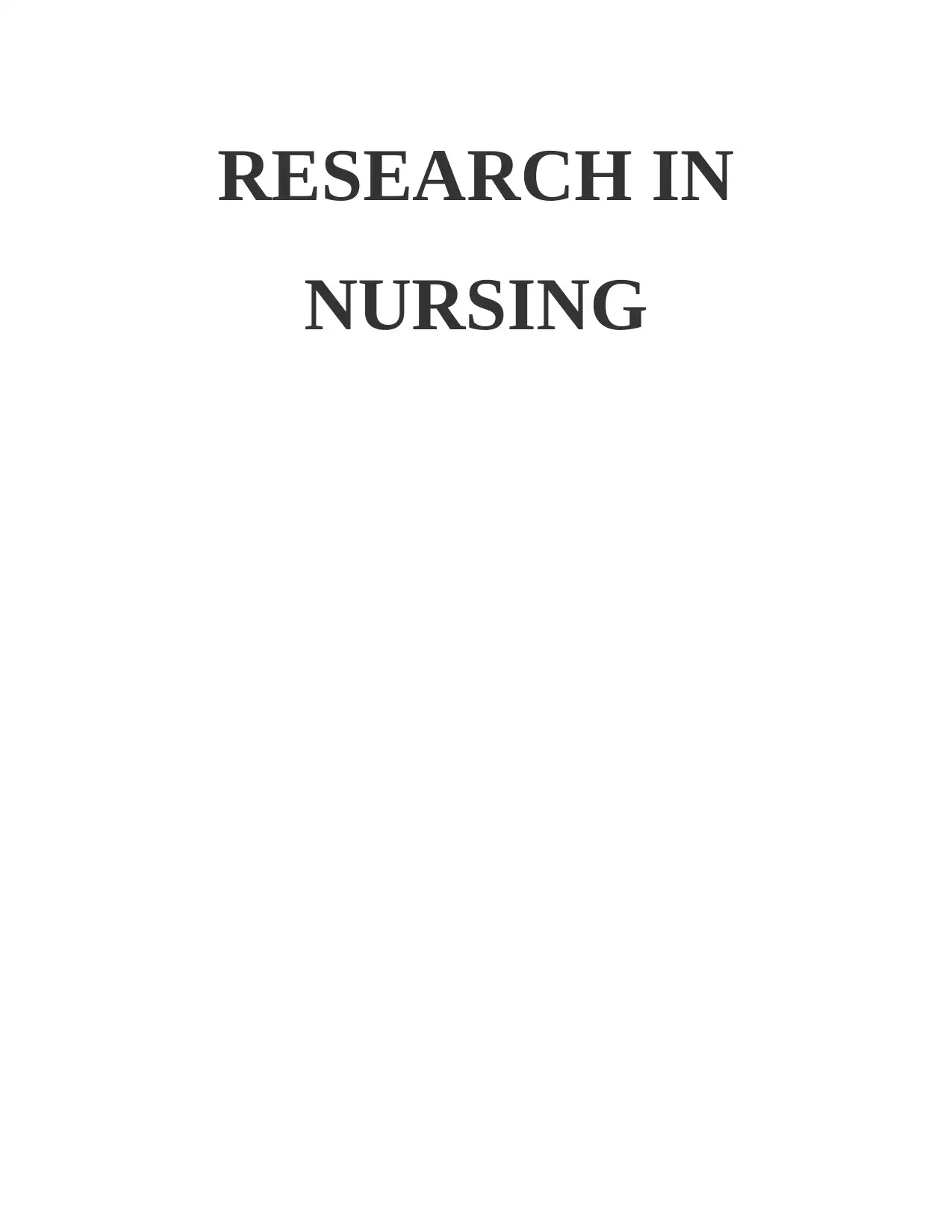
RESEARCH IN
NURSING
NURSING
Paraphrase This Document
Need a fresh take? Get an instant paraphrase of this document with our AI Paraphraser
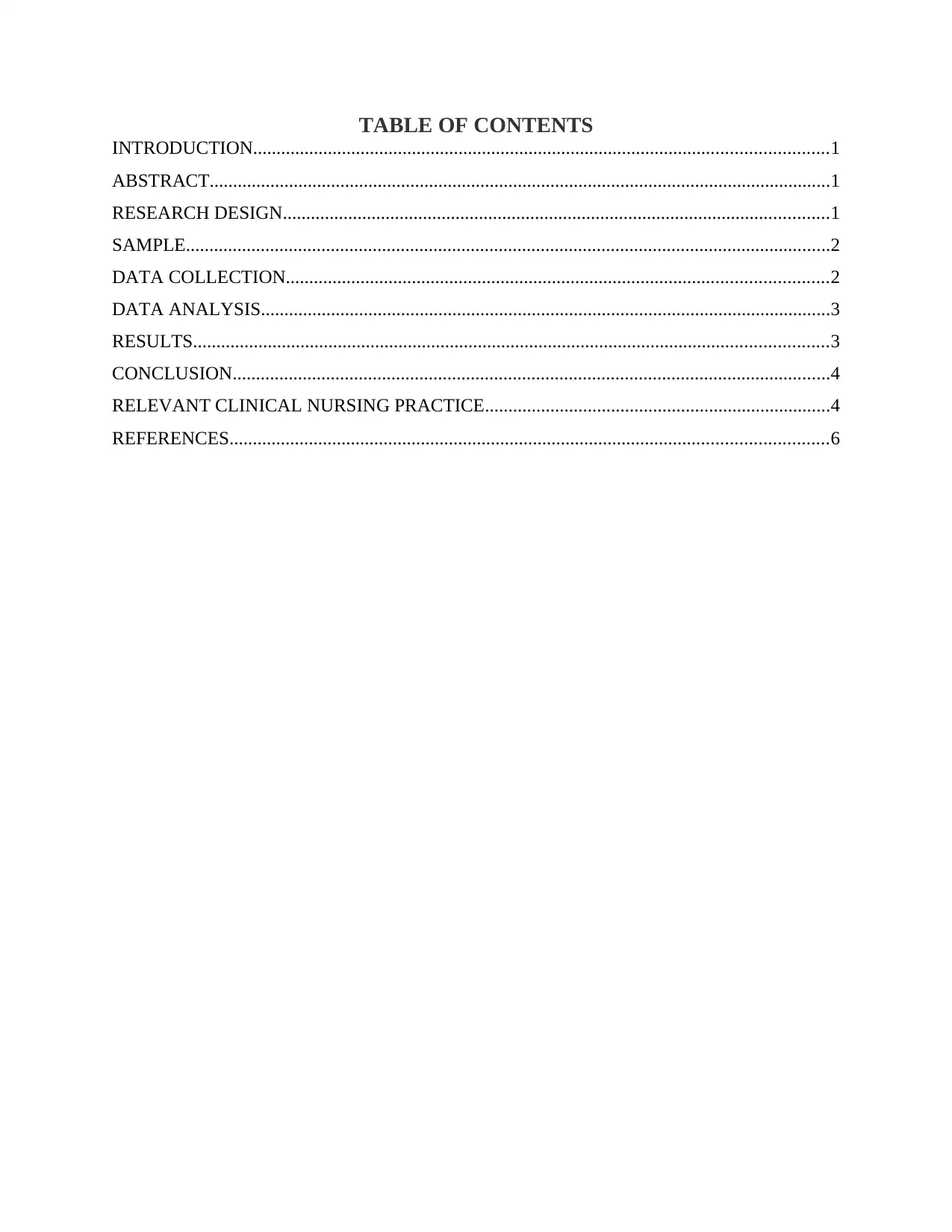
TABLE OF CONTENTS
INTRODUCTION...........................................................................................................................1
ABSTRACT.....................................................................................................................................1
RESEARCH DESIGN.....................................................................................................................1
SAMPLE..........................................................................................................................................2
DATA COLLECTION....................................................................................................................2
DATA ANALYSIS..........................................................................................................................3
RESULTS........................................................................................................................................3
CONCLUSION................................................................................................................................4
RELEVANT CLINICAL NURSING PRACTICE..........................................................................4
REFERENCES................................................................................................................................6
INTRODUCTION...........................................................................................................................1
ABSTRACT.....................................................................................................................................1
RESEARCH DESIGN.....................................................................................................................1
SAMPLE..........................................................................................................................................2
DATA COLLECTION....................................................................................................................2
DATA ANALYSIS..........................................................................................................................3
RESULTS........................................................................................................................................3
CONCLUSION................................................................................................................................4
RELEVANT CLINICAL NURSING PRACTICE..........................................................................4
REFERENCES................................................................................................................................6
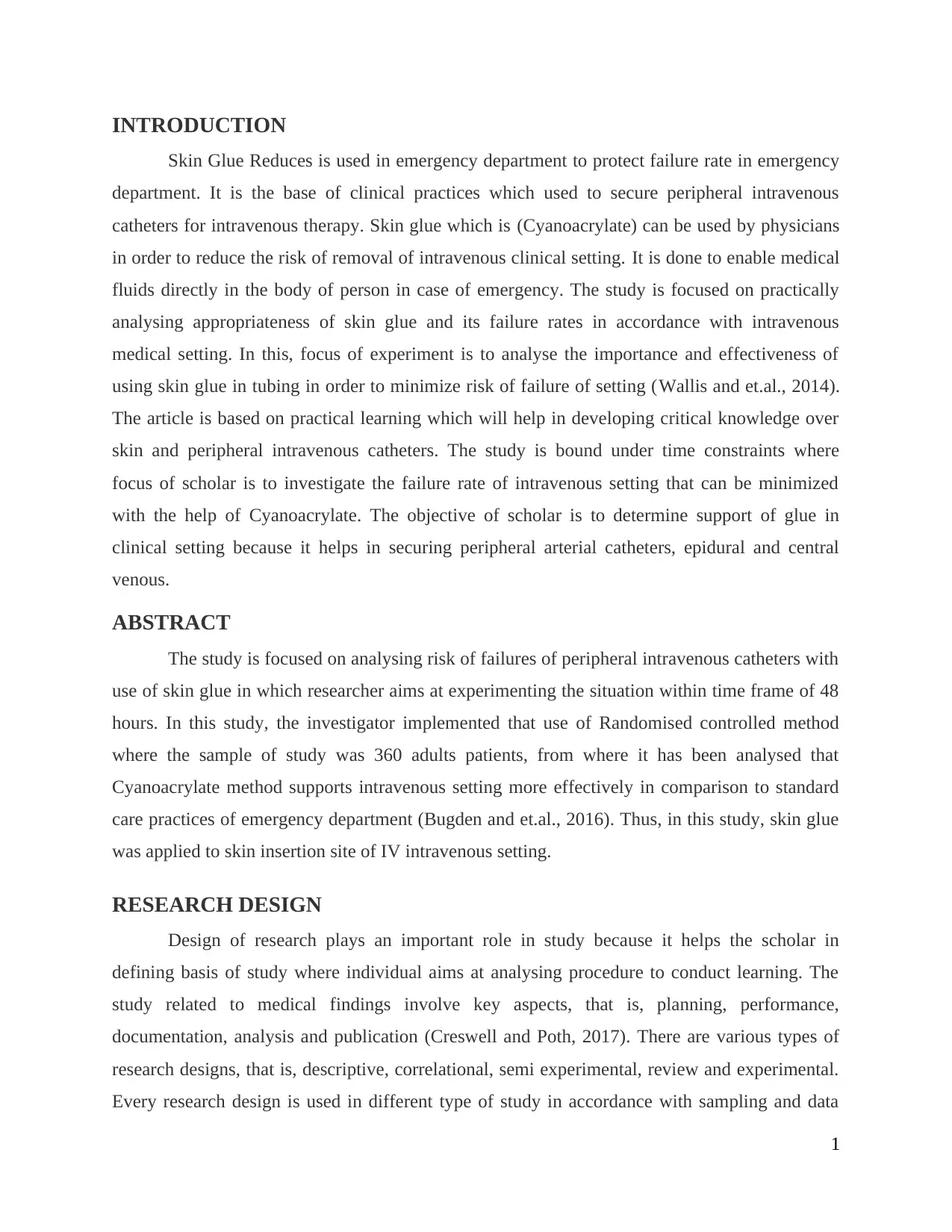
INTRODUCTION
Skin Glue Reduces is used in emergency department to protect failure rate in emergency
department. It is the base of clinical practices which used to secure peripheral intravenous
catheters for intravenous therapy. Skin glue which is (Cyanoacrylate) can be used by physicians
in order to reduce the risk of removal of intravenous clinical setting. It is done to enable medical
fluids directly in the body of person in case of emergency. The study is focused on practically
analysing appropriateness of skin glue and its failure rates in accordance with intravenous
medical setting. In this, focus of experiment is to analyse the importance and effectiveness of
using skin glue in tubing in order to minimize risk of failure of setting (Wallis and et.al., 2014).
The article is based on practical learning which will help in developing critical knowledge over
skin and peripheral intravenous catheters. The study is bound under time constraints where
focus of scholar is to investigate the failure rate of intravenous setting that can be minimized
with the help of Cyanoacrylate. The objective of scholar is to determine support of glue in
clinical setting because it helps in securing peripheral arterial catheters, epidural and central
venous.
ABSTRACT
The study is focused on analysing risk of failures of peripheral intravenous catheters with
use of skin glue in which researcher aims at experimenting the situation within time frame of 48
hours. In this study, the investigator implemented that use of Randomised controlled method
where the sample of study was 360 adults patients, from where it has been analysed that
Cyanoacrylate method supports intravenous setting more effectively in comparison to standard
care practices of emergency department (Bugden and et.al., 2016). Thus, in this study, skin glue
was applied to skin insertion site of IV intravenous setting.
RESEARCH DESIGN
Design of research plays an important role in study because it helps the scholar in
defining basis of study where individual aims at analysing procedure to conduct learning. The
study related to medical findings involve key aspects, that is, planning, performance,
documentation, analysis and publication (Creswell and Poth, 2017). There are various types of
research designs, that is, descriptive, correlational, semi experimental, review and experimental.
Every research design is used in different type of study in accordance with sampling and data
1
Skin Glue Reduces is used in emergency department to protect failure rate in emergency
department. It is the base of clinical practices which used to secure peripheral intravenous
catheters for intravenous therapy. Skin glue which is (Cyanoacrylate) can be used by physicians
in order to reduce the risk of removal of intravenous clinical setting. It is done to enable medical
fluids directly in the body of person in case of emergency. The study is focused on practically
analysing appropriateness of skin glue and its failure rates in accordance with intravenous
medical setting. In this, focus of experiment is to analyse the importance and effectiveness of
using skin glue in tubing in order to minimize risk of failure of setting (Wallis and et.al., 2014).
The article is based on practical learning which will help in developing critical knowledge over
skin and peripheral intravenous catheters. The study is bound under time constraints where
focus of scholar is to investigate the failure rate of intravenous setting that can be minimized
with the help of Cyanoacrylate. The objective of scholar is to determine support of glue in
clinical setting because it helps in securing peripheral arterial catheters, epidural and central
venous.
ABSTRACT
The study is focused on analysing risk of failures of peripheral intravenous catheters with
use of skin glue in which researcher aims at experimenting the situation within time frame of 48
hours. In this study, the investigator implemented that use of Randomised controlled method
where the sample of study was 360 adults patients, from where it has been analysed that
Cyanoacrylate method supports intravenous setting more effectively in comparison to standard
care practices of emergency department (Bugden and et.al., 2016). Thus, in this study, skin glue
was applied to skin insertion site of IV intravenous setting.
RESEARCH DESIGN
Design of research plays an important role in study because it helps the scholar in
defining basis of study where individual aims at analysing procedure to conduct learning. The
study related to medical findings involve key aspects, that is, planning, performance,
documentation, analysis and publication (Creswell and Poth, 2017). There are various types of
research designs, that is, descriptive, correlational, semi experimental, review and experimental.
Every research design is used in different type of study in accordance with sampling and data
1
⊘ This is a preview!⊘
Do you want full access?
Subscribe today to unlock all pages.

Trusted by 1+ million students worldwide
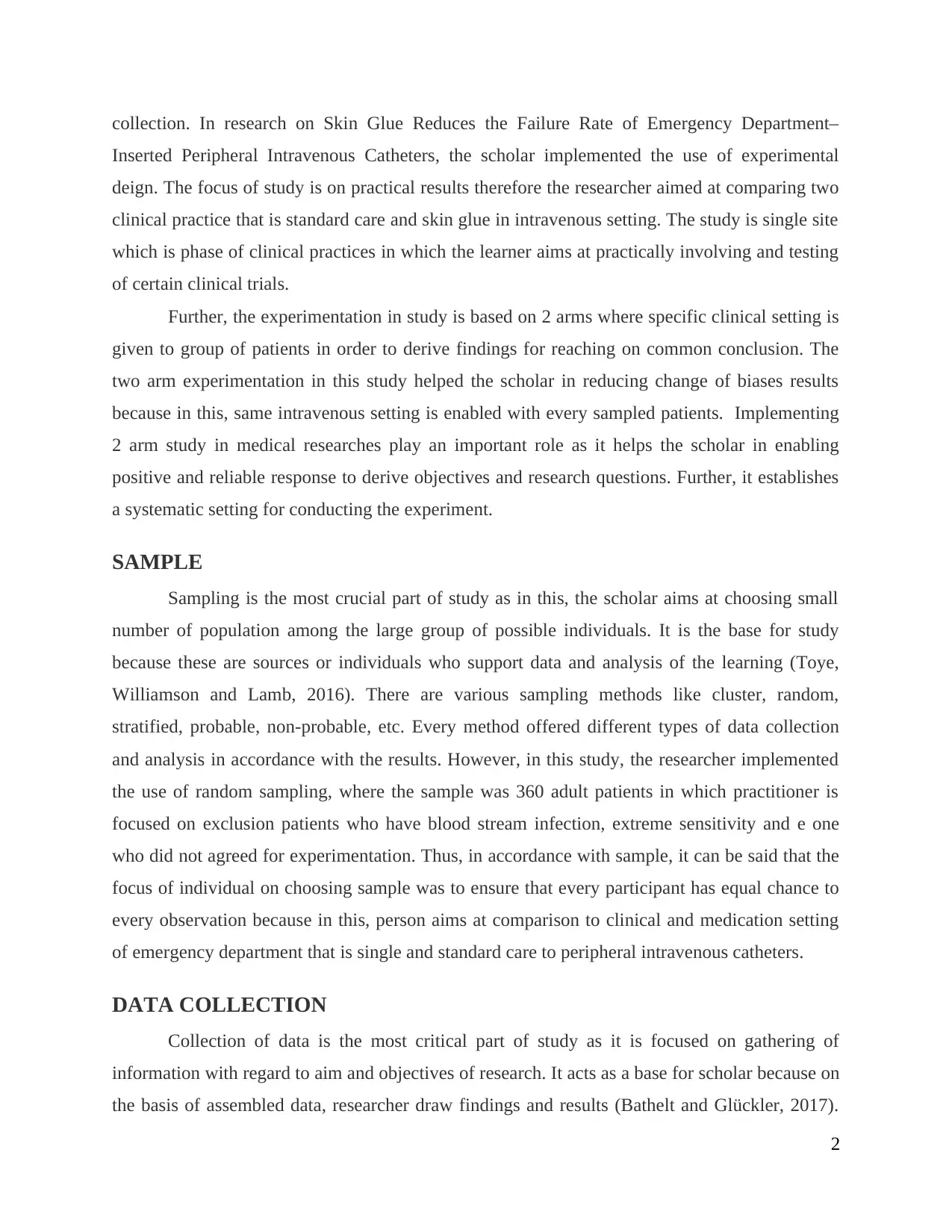
collection. In research on Skin Glue Reduces the Failure Rate of Emergency Department–
Inserted Peripheral Intravenous Catheters, the scholar implemented the use of experimental
deign. The focus of study is on practical results therefore the researcher aimed at comparing two
clinical practice that is standard care and skin glue in intravenous setting. The study is single site
which is phase of clinical practices in which the learner aims at practically involving and testing
of certain clinical trials.
Further, the experimentation in study is based on 2 arms where specific clinical setting is
given to group of patients in order to derive findings for reaching on common conclusion. The
two arm experimentation in this study helped the scholar in reducing change of biases results
because in this, same intravenous setting is enabled with every sampled patients. Implementing
2 arm study in medical researches play an important role as it helps the scholar in enabling
positive and reliable response to derive objectives and research questions. Further, it establishes
a systematic setting for conducting the experiment.
SAMPLE
Sampling is the most crucial part of study as in this, the scholar aims at choosing small
number of population among the large group of possible individuals. It is the base for study
because these are sources or individuals who support data and analysis of the learning (Toye,
Williamson and Lamb, 2016). There are various sampling methods like cluster, random,
stratified, probable, non-probable, etc. Every method offered different types of data collection
and analysis in accordance with the results. However, in this study, the researcher implemented
the use of random sampling, where the sample was 360 adult patients in which practitioner is
focused on exclusion patients who have blood stream infection, extreme sensitivity and e one
who did not agreed for experimentation. Thus, in accordance with sample, it can be said that the
focus of individual on choosing sample was to ensure that every participant has equal chance to
every observation because in this, person aims at comparison to clinical and medication setting
of emergency department that is single and standard care to peripheral intravenous catheters.
DATA COLLECTION
Collection of data is the most critical part of study as it is focused on gathering of
information with regard to aim and objectives of research. It acts as a base for scholar because on
the basis of assembled data, researcher draw findings and results (Bathelt and Glückler, 2017).
2
Inserted Peripheral Intravenous Catheters, the scholar implemented the use of experimental
deign. The focus of study is on practical results therefore the researcher aimed at comparing two
clinical practice that is standard care and skin glue in intravenous setting. The study is single site
which is phase of clinical practices in which the learner aims at practically involving and testing
of certain clinical trials.
Further, the experimentation in study is based on 2 arms where specific clinical setting is
given to group of patients in order to derive findings for reaching on common conclusion. The
two arm experimentation in this study helped the scholar in reducing change of biases results
because in this, same intravenous setting is enabled with every sampled patients. Implementing
2 arm study in medical researches play an important role as it helps the scholar in enabling
positive and reliable response to derive objectives and research questions. Further, it establishes
a systematic setting for conducting the experiment.
SAMPLE
Sampling is the most crucial part of study as in this, the scholar aims at choosing small
number of population among the large group of possible individuals. It is the base for study
because these are sources or individuals who support data and analysis of the learning (Toye,
Williamson and Lamb, 2016). There are various sampling methods like cluster, random,
stratified, probable, non-probable, etc. Every method offered different types of data collection
and analysis in accordance with the results. However, in this study, the researcher implemented
the use of random sampling, where the sample was 360 adult patients in which practitioner is
focused on exclusion patients who have blood stream infection, extreme sensitivity and e one
who did not agreed for experimentation. Thus, in accordance with sample, it can be said that the
focus of individual on choosing sample was to ensure that every participant has equal chance to
every observation because in this, person aims at comparison to clinical and medication setting
of emergency department that is single and standard care to peripheral intravenous catheters.
DATA COLLECTION
Collection of data is the most critical part of study as it is focused on gathering of
information with regard to aim and objectives of research. It acts as a base for scholar because on
the basis of assembled data, researcher draw findings and results (Bathelt and Glückler, 2017).
2
Paraphrase This Document
Need a fresh take? Get an instant paraphrase of this document with our AI Paraphraser
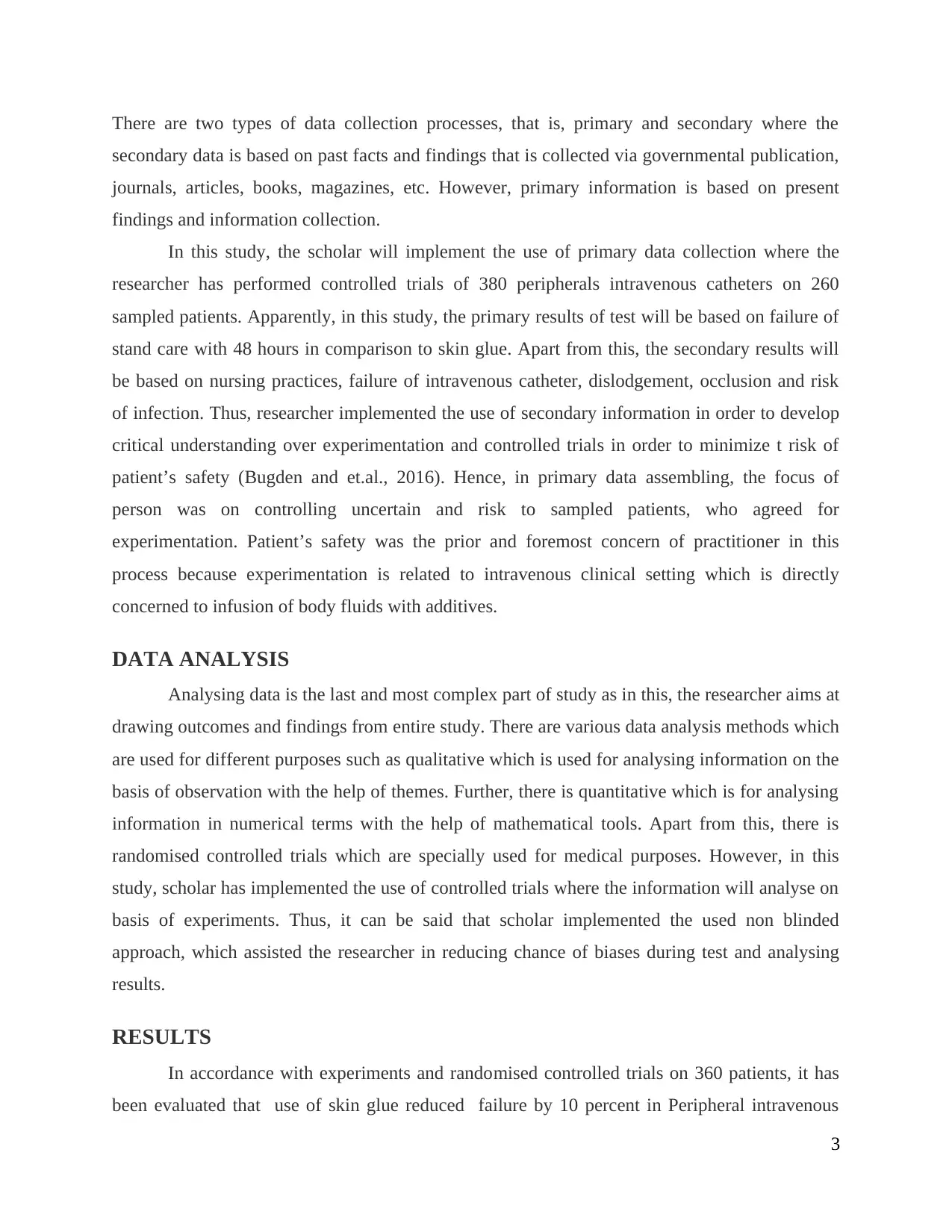
There are two types of data collection processes, that is, primary and secondary where the
secondary data is based on past facts and findings that is collected via governmental publication,
journals, articles, books, magazines, etc. However, primary information is based on present
findings and information collection.
In this study, the scholar will implement the use of primary data collection where the
researcher has performed controlled trials of 380 peripherals intravenous catheters on 260
sampled patients. Apparently, in this study, the primary results of test will be based on failure of
stand care with 48 hours in comparison to skin glue. Apart from this, the secondary results will
be based on nursing practices, failure of intravenous catheter, dislodgement, occlusion and risk
of infection. Thus, researcher implemented the use of secondary information in order to develop
critical understanding over experimentation and controlled trials in order to minimize t risk of
patient’s safety (Bugden and et.al., 2016). Hence, in primary data assembling, the focus of
person was on controlling uncertain and risk to sampled patients, who agreed for
experimentation. Patient’s safety was the prior and foremost concern of practitioner in this
process because experimentation is related to intravenous clinical setting which is directly
concerned to infusion of body fluids with additives.
DATA ANALYSIS
Analysing data is the last and most complex part of study as in this, the researcher aims at
drawing outcomes and findings from entire study. There are various data analysis methods which
are used for different purposes such as qualitative which is used for analysing information on the
basis of observation with the help of themes. Further, there is quantitative which is for analysing
information in numerical terms with the help of mathematical tools. Apart from this, there is
randomised controlled trials which are specially used for medical purposes. However, in this
study, scholar has implemented the use of controlled trials where the information will analyse on
basis of experiments. Thus, it can be said that scholar implemented the used non blinded
approach, which assisted the researcher in reducing chance of biases during test and analysing
results.
RESULTS
In accordance with experiments and randomised controlled trials on 360 patients, it has
been evaluated that use of skin glue reduced failure by 10 percent in Peripheral intravenous
3
secondary data is based on past facts and findings that is collected via governmental publication,
journals, articles, books, magazines, etc. However, primary information is based on present
findings and information collection.
In this study, the scholar will implement the use of primary data collection where the
researcher has performed controlled trials of 380 peripherals intravenous catheters on 260
sampled patients. Apparently, in this study, the primary results of test will be based on failure of
stand care with 48 hours in comparison to skin glue. Apart from this, the secondary results will
be based on nursing practices, failure of intravenous catheter, dislodgement, occlusion and risk
of infection. Thus, researcher implemented the use of secondary information in order to develop
critical understanding over experimentation and controlled trials in order to minimize t risk of
patient’s safety (Bugden and et.al., 2016). Hence, in primary data assembling, the focus of
person was on controlling uncertain and risk to sampled patients, who agreed for
experimentation. Patient’s safety was the prior and foremost concern of practitioner in this
process because experimentation is related to intravenous clinical setting which is directly
concerned to infusion of body fluids with additives.
DATA ANALYSIS
Analysing data is the last and most complex part of study as in this, the researcher aims at
drawing outcomes and findings from entire study. There are various data analysis methods which
are used for different purposes such as qualitative which is used for analysing information on the
basis of observation with the help of themes. Further, there is quantitative which is for analysing
information in numerical terms with the help of mathematical tools. Apart from this, there is
randomised controlled trials which are specially used for medical purposes. However, in this
study, scholar has implemented the use of controlled trials where the information will analyse on
basis of experiments. Thus, it can be said that scholar implemented the used non blinded
approach, which assisted the researcher in reducing chance of biases during test and analysing
results.
RESULTS
In accordance with experiments and randomised controlled trials on 360 patients, it has
been evaluated that use of skin glue reduced failure by 10 percent in Peripheral intravenous
3
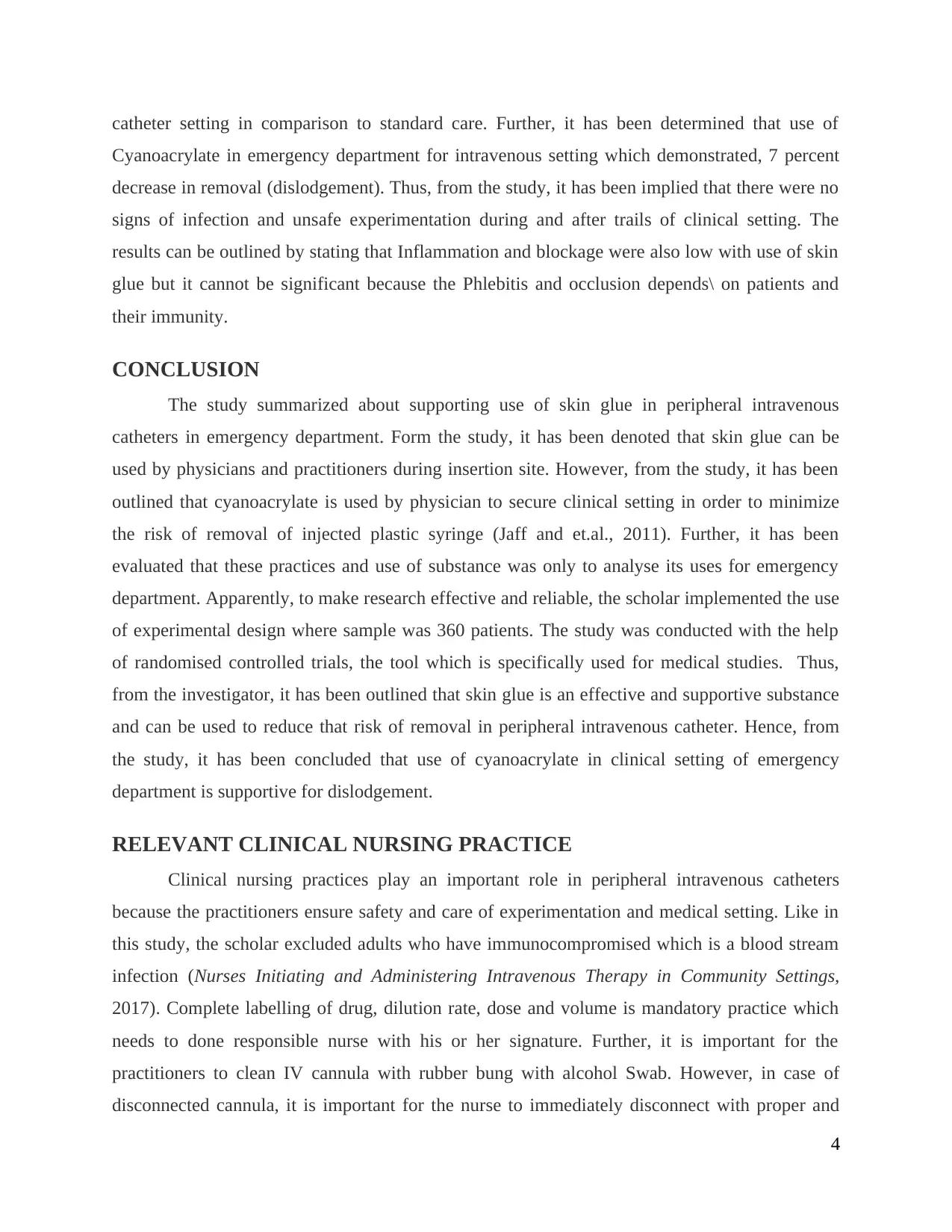
catheter setting in comparison to standard care. Further, it has been determined that use of
Cyanoacrylate in emergency department for intravenous setting which demonstrated, 7 percent
decrease in removal (dislodgement). Thus, from the study, it has been implied that there were no
signs of infection and unsafe experimentation during and after trails of clinical setting. The
results can be outlined by stating that Inflammation and blockage were also low with use of skin
glue but it cannot be significant because the Phlebitis and occlusion depends\ on patients and
their immunity.
CONCLUSION
The study summarized about supporting use of skin glue in peripheral intravenous
catheters in emergency department. Form the study, it has been denoted that skin glue can be
used by physicians and practitioners during insertion site. However, from the study, it has been
outlined that cyanoacrylate is used by physician to secure clinical setting in order to minimize
the risk of removal of injected plastic syringe (Jaff and et.al., 2011). Further, it has been
evaluated that these practices and use of substance was only to analyse its uses for emergency
department. Apparently, to make research effective and reliable, the scholar implemented the use
of experimental design where sample was 360 patients. The study was conducted with the help
of randomised controlled trials, the tool which is specifically used for medical studies. Thus,
from the investigator, it has been outlined that skin glue is an effective and supportive substance
and can be used to reduce that risk of removal in peripheral intravenous catheter. Hence, from
the study, it has been concluded that use of cyanoacrylate in clinical setting of emergency
department is supportive for dislodgement.
RELEVANT CLINICAL NURSING PRACTICE
Clinical nursing practices play an important role in peripheral intravenous catheters
because the practitioners ensure safety and care of experimentation and medical setting. Like in
this study, the scholar excluded adults who have immunocompromised which is a blood stream
infection (Nurses Initiating and Administering Intravenous Therapy in Community Settings,
2017). Complete labelling of drug, dilution rate, dose and volume is mandatory practice which
needs to done responsible nurse with his or her signature. Further, it is important for the
practitioners to clean IV cannula with rubber bung with alcohol Swab. However, in case of
disconnected cannula, it is important for the nurse to immediately disconnect with proper and
4
Cyanoacrylate in emergency department for intravenous setting which demonstrated, 7 percent
decrease in removal (dislodgement). Thus, from the study, it has been implied that there were no
signs of infection and unsafe experimentation during and after trails of clinical setting. The
results can be outlined by stating that Inflammation and blockage were also low with use of skin
glue but it cannot be significant because the Phlebitis and occlusion depends\ on patients and
their immunity.
CONCLUSION
The study summarized about supporting use of skin glue in peripheral intravenous
catheters in emergency department. Form the study, it has been denoted that skin glue can be
used by physicians and practitioners during insertion site. However, from the study, it has been
outlined that cyanoacrylate is used by physician to secure clinical setting in order to minimize
the risk of removal of injected plastic syringe (Jaff and et.al., 2011). Further, it has been
evaluated that these practices and use of substance was only to analyse its uses for emergency
department. Apparently, to make research effective and reliable, the scholar implemented the use
of experimental design where sample was 360 patients. The study was conducted with the help
of randomised controlled trials, the tool which is specifically used for medical studies. Thus,
from the investigator, it has been outlined that skin glue is an effective and supportive substance
and can be used to reduce that risk of removal in peripheral intravenous catheter. Hence, from
the study, it has been concluded that use of cyanoacrylate in clinical setting of emergency
department is supportive for dislodgement.
RELEVANT CLINICAL NURSING PRACTICE
Clinical nursing practices play an important role in peripheral intravenous catheters
because the practitioners ensure safety and care of experimentation and medical setting. Like in
this study, the scholar excluded adults who have immunocompromised which is a blood stream
infection (Nurses Initiating and Administering Intravenous Therapy in Community Settings,
2017). Complete labelling of drug, dilution rate, dose and volume is mandatory practice which
needs to done responsible nurse with his or her signature. Further, it is important for the
practitioners to clean IV cannula with rubber bung with alcohol Swab. However, in case of
disconnected cannula, it is important for the nurse to immediately disconnect with proper and
4
⊘ This is a preview!⊘
Do you want full access?
Subscribe today to unlock all pages.

Trusted by 1+ million students worldwide

flush it for avoiding infection. Further, it is the responsibility of practitioner to clean the blood
substances and syringe driver in order to prevent outward flow of blood (Rickard and et.al.,
2012).
Label infusion is the foremost clinical nursing practice which comprises labelling of fluid
bag with proper date and time. Further, it is important for the practitioner to describe about the
nearest line to pump in cases of multiple line connected. Hence, in accordance with the label, it
is important for health practitioners to ensure labelling with appropriate time, patient name and
signature of nurse who has been responsible to keep check on specific patient.
Apart from this, relevant clinical nursing practice with regard to peripheral intravenous
catheters, states that the practitioners are responsible for changing IV bags and lines on
appropriate time mentioned in prescription. In this, the focus of individuals is on additives and
non-additives in infusion, Lipid and blood products. However, in bag change and line change,
the practices of nurses focus on changing non additives' infusion within 72 hours. Apparently,
bag change of additive infusion is within 24 hours whereas line is changed in every 72 hours.
The bad of lipid is changed by nurses in every 24 hours and line is changed in every 72 hours
(Tuffaha and et.al., 2014). However, in case of blood products, the bag is changed in every 4
hours and line is changed up to 12 hours in order to minimize risk of disconnection and outward
flow of body fluid.
Removal of peripheral intravenous catheters is due to extravasation, infiltration,
discomfort, signs of infection and swelling. In such cases of removal, the practices need to
ensure hand hygiene where the nurses aim at wearing non sterile gloves. Further, it is important
for the practitioner to carefully remove clinical setting (Wallis and et.al., 2014). The removal of
IV setting leads to outward flow of blood for which it is important for the nurses to hold sterilize
cotton wool to place it to exit site to block flow. However, nursing practices in intravenous
setting play a critical role in deriving supportive setting for dislodgement. The nurse’s practice
for intravenous ensures use of safe medication equipment and products. Further, checking
intravenous setting and products against prescription is another responsibility which helps the
health professionals in establishing safe practices (Nurses Initiating and Administering
Intravenous Therapy in Community Settings, 2017). Hence, it can be outlined that following of
nursing practices in clinical setting for peripheral intravenous catheters help practitioners and
professionals in managing safe and secured patient care in health care organisation.
5
substances and syringe driver in order to prevent outward flow of blood (Rickard and et.al.,
2012).
Label infusion is the foremost clinical nursing practice which comprises labelling of fluid
bag with proper date and time. Further, it is important for the practitioner to describe about the
nearest line to pump in cases of multiple line connected. Hence, in accordance with the label, it
is important for health practitioners to ensure labelling with appropriate time, patient name and
signature of nurse who has been responsible to keep check on specific patient.
Apart from this, relevant clinical nursing practice with regard to peripheral intravenous
catheters, states that the practitioners are responsible for changing IV bags and lines on
appropriate time mentioned in prescription. In this, the focus of individuals is on additives and
non-additives in infusion, Lipid and blood products. However, in bag change and line change,
the practices of nurses focus on changing non additives' infusion within 72 hours. Apparently,
bag change of additive infusion is within 24 hours whereas line is changed in every 72 hours.
The bad of lipid is changed by nurses in every 24 hours and line is changed in every 72 hours
(Tuffaha and et.al., 2014). However, in case of blood products, the bag is changed in every 4
hours and line is changed up to 12 hours in order to minimize risk of disconnection and outward
flow of body fluid.
Removal of peripheral intravenous catheters is due to extravasation, infiltration,
discomfort, signs of infection and swelling. In such cases of removal, the practices need to
ensure hand hygiene where the nurses aim at wearing non sterile gloves. Further, it is important
for the practitioner to carefully remove clinical setting (Wallis and et.al., 2014). The removal of
IV setting leads to outward flow of blood for which it is important for the nurses to hold sterilize
cotton wool to place it to exit site to block flow. However, nursing practices in intravenous
setting play a critical role in deriving supportive setting for dislodgement. The nurse’s practice
for intravenous ensures use of safe medication equipment and products. Further, checking
intravenous setting and products against prescription is another responsibility which helps the
health professionals in establishing safe practices (Nurses Initiating and Administering
Intravenous Therapy in Community Settings, 2017). Hence, it can be outlined that following of
nursing practices in clinical setting for peripheral intravenous catheters help practitioners and
professionals in managing safe and secured patient care in health care organisation.
5
Paraphrase This Document
Need a fresh take? Get an instant paraphrase of this document with our AI Paraphraser
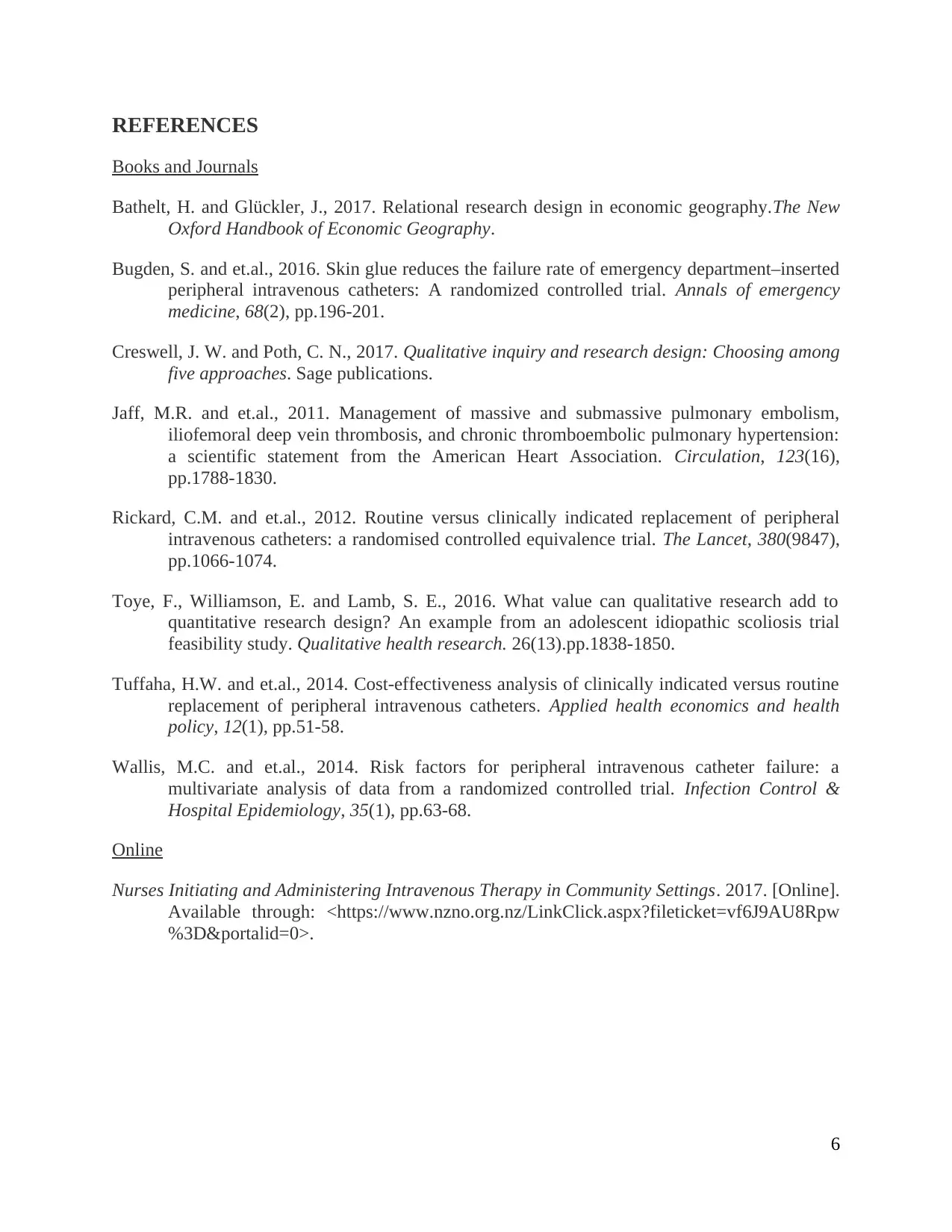
REFERENCES
Books and Journals
Bathelt, H. and Glückler, J., 2017. Relational research design in economic geography.The New
Oxford Handbook of Economic Geography.
Bugden, S. and et.al., 2016. Skin glue reduces the failure rate of emergency department–inserted
peripheral intravenous catheters: A randomized controlled trial. Annals of emergency
medicine, 68(2), pp.196-201.
Creswell, J. W. and Poth, C. N., 2017. Qualitative inquiry and research design: Choosing among
five approaches. Sage publications.
Jaff, M.R. and et.al., 2011. Management of massive and submassive pulmonary embolism,
iliofemoral deep vein thrombosis, and chronic thromboembolic pulmonary hypertension:
a scientific statement from the American Heart Association. Circulation, 123(16),
pp.1788-1830.
Rickard, C.M. and et.al., 2012. Routine versus clinically indicated replacement of peripheral
intravenous catheters: a randomised controlled equivalence trial. The Lancet, 380(9847),
pp.1066-1074.
Toye, F., Williamson, E. and Lamb, S. E., 2016. What value can qualitative research add to
quantitative research design? An example from an adolescent idiopathic scoliosis trial
feasibility study. Qualitative health research. 26(13).pp.1838-1850.
Tuffaha, H.W. and et.al., 2014. Cost-effectiveness analysis of clinically indicated versus routine
replacement of peripheral intravenous catheters. Applied health economics and health
policy, 12(1), pp.51-58.
Wallis, M.C. and et.al., 2014. Risk factors for peripheral intravenous catheter failure: a
multivariate analysis of data from a randomized controlled trial. Infection Control &
Hospital Epidemiology, 35(1), pp.63-68.
Online
Nurses Initiating and Administering Intravenous Therapy in Community Settings. 2017. [Online].
Available through: <https://www.nzno.org.nz/LinkClick.aspx?fileticket=vf6J9AU8Rpw
%3D&portalid=0>.
6
Books and Journals
Bathelt, H. and Glückler, J., 2017. Relational research design in economic geography.The New
Oxford Handbook of Economic Geography.
Bugden, S. and et.al., 2016. Skin glue reduces the failure rate of emergency department–inserted
peripheral intravenous catheters: A randomized controlled trial. Annals of emergency
medicine, 68(2), pp.196-201.
Creswell, J. W. and Poth, C. N., 2017. Qualitative inquiry and research design: Choosing among
five approaches. Sage publications.
Jaff, M.R. and et.al., 2011. Management of massive and submassive pulmonary embolism,
iliofemoral deep vein thrombosis, and chronic thromboembolic pulmonary hypertension:
a scientific statement from the American Heart Association. Circulation, 123(16),
pp.1788-1830.
Rickard, C.M. and et.al., 2012. Routine versus clinically indicated replacement of peripheral
intravenous catheters: a randomised controlled equivalence trial. The Lancet, 380(9847),
pp.1066-1074.
Toye, F., Williamson, E. and Lamb, S. E., 2016. What value can qualitative research add to
quantitative research design? An example from an adolescent idiopathic scoliosis trial
feasibility study. Qualitative health research. 26(13).pp.1838-1850.
Tuffaha, H.W. and et.al., 2014. Cost-effectiveness analysis of clinically indicated versus routine
replacement of peripheral intravenous catheters. Applied health economics and health
policy, 12(1), pp.51-58.
Wallis, M.C. and et.al., 2014. Risk factors for peripheral intravenous catheter failure: a
multivariate analysis of data from a randomized controlled trial. Infection Control &
Hospital Epidemiology, 35(1), pp.63-68.
Online
Nurses Initiating and Administering Intravenous Therapy in Community Settings. 2017. [Online].
Available through: <https://www.nzno.org.nz/LinkClick.aspx?fileticket=vf6J9AU8Rpw
%3D&portalid=0>.
6
1 out of 8
Related Documents
Your All-in-One AI-Powered Toolkit for Academic Success.
+13062052269
info@desklib.com
Available 24*7 on WhatsApp / Email
![[object Object]](/_next/static/media/star-bottom.7253800d.svg)
Unlock your academic potential
Copyright © 2020–2025 A2Z Services. All Rights Reserved. Developed and managed by ZUCOL.





